If you are traveling on the Richardson Highway from Gakona to Fairbanks, there are a few amazing stops along the way. Particularly, a stopover in Delta Junction is a must-do for any Alaskan itinerary. Delta Junction lies on the Valdez-Fairbanks trail that was constructed from 1902 to 1903 as a winter route to the goldfields of the Tanana River valley. We made it a point to have a pit-stop in Delta Junction while travelling from Gakona to Fairbanks. This was part of our itinerary on the grand circle from Wrangell St. Elias to Denali National Park.

We started our day early, leaving the Airbnb at Pippen Lake. Sadly, we will miss the log cabin on the lake. I think at some point we will return. Wrangell St. Elias has so much more for us to explore. Just off the Richardson’s highway, the cabin is close to both the park and Valdez. We make the brief stop at Willow Lake. The viewpoint on a clear day has magnificent views of Mount Drum, Mount Sanford, Mount Wrangell and Mount Blackburn. The Richardson Highway diverts from the Glenn Highway at Glenallen.
This post may contain affiliate links, meaning if you purchase something through one of these links, we may earn a small commission at no extra cost to you! Read the full disclosure policy here
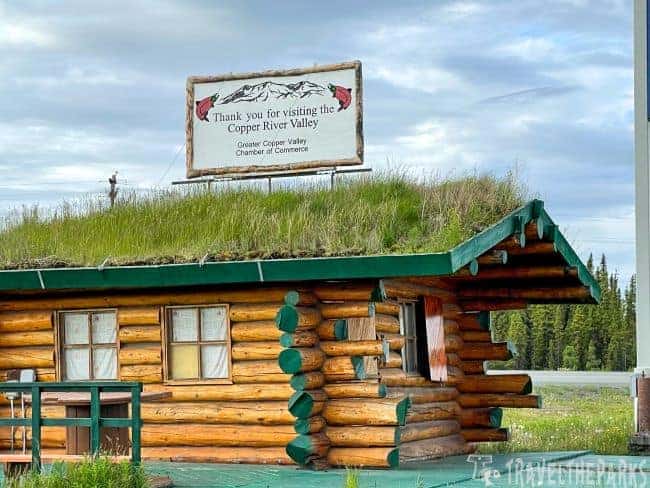
Table of Contents
Start Your Journey with the Stunning Copper River Valley on the Richardson Highway Route
The copper river valley has a rich mining history. The highway meanders through the valley with endless views of the Wrangell mountains. Today, although the skies are overcast, we are still in awe of how lucky we are to be here. The temperatures are still quite cool, but it does not stop us from doing a few hikes along the way to Delta Junction and Fairbanks. After a brief break in Glenallen (MM115) for gas, we head towards Gulkana. The Richardson (Alaska Route 4) runs 368 miles and connecting Valdez to Fairbanks. In the valley, it runs along the Copper River.
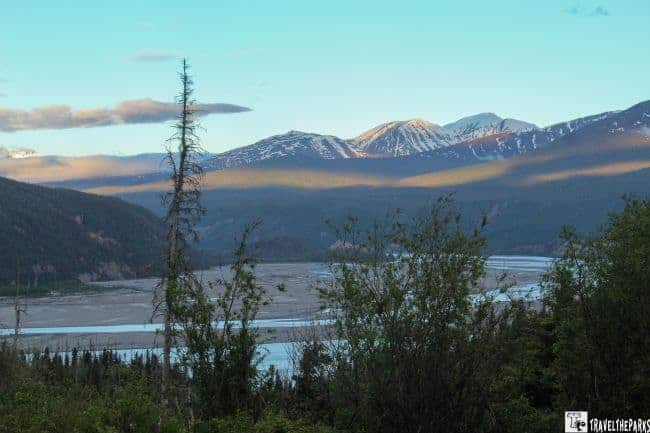
The Gulkana River Bridge (MM127) is an excellent place to cast a fly line for trout. The river is a clear-water system home to native rainbow trout, Arctic grayling and seasonal kings and sockeye salmon. We make a brief detour to try our luck at fishing. The river is quite high, and running fast. After a few minutes, we decide the conditions are not ideal and head back onto the Richardson highway.
NOTE: Alaska is a wilderness area with plenty of grizzly bears, so consider taking bear spray.

Explore Gakona Village – A Key Stop Along the Tok Cutoff Near the Richardson Highway
Rooted in the days of the gold rush, the Richardson Highway terrain has transitioned to dense black spruce thicket. The lowland valleys, meandering rivers and wetlands are predominately willow, alder, and dwarf birch. Moose prefer the grasses, sedges and leaves of these shrubs. Lots of moose along the highway early this morning dining on these favorable delicacies. We near Gakona is a tiny native village at the junction of the Richardsons and the Tok cutoff (MM128). The primary draw here is the river. Designated a National Wild and Scenic River above the Sourdough area, the Gulkana is one of the most popular sportfishing rivers in Alaska. Every year salmon fill the stream intent on spawning in the clear waters.
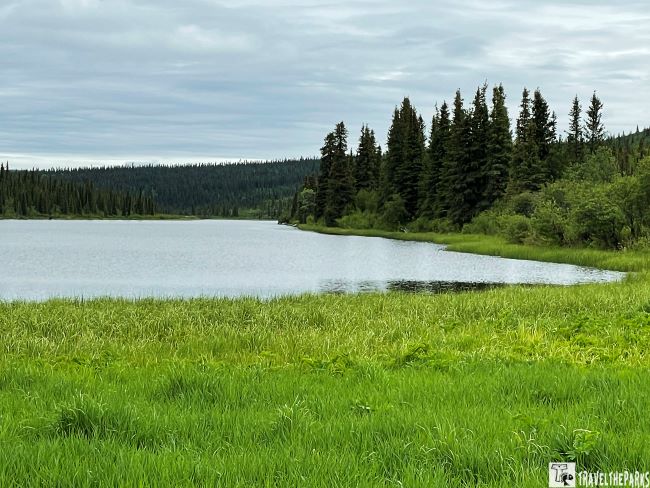
The short 0.5-mile Gulkana River Trail is worth the brief stop. Before taking the trail, apply plenty of bug spray as Alaska’s national bird, the pesky mosquito was thriving on this cloudy day. The meandering river snakes its way through the lowland valley. The water we notice is incredibly clear. You can see into the deeper section. I wish we had more time to fish this section, but alas, we have to keep moving.
NOTE: Be aware that there will be several places along the highway where you’ll have to slow down. Lots of rolls and the bumps. At some construction zones, you will need to wait for the pilot car to traverse the reconstruction roadwork. The Alaska Department of Transportation is working to reconstruct the Richardson Highway between MP 159 to 167.

Sourdough (MM 147) – A Rustic Stop Along the Richardson Highway Between Gakona and Delta Junction
They consider the river at canyon rapids to be Class III-IV for those that want a river rafting experience. The 1/2 mile canyon is quite a wild ride. Most rafters put in near Paxton lake with take out at the Sourdough Campground at Mile 127. There are rafting companies that will take you through the rapids. This is an item we will add to our bucket list for our next trip. I could see the rafters drifting down the river as we continued on the Richardson.
At mile marker 170, we stop for lunch at Meier’s Lake Roadhouse but sadly it was closed in 2009. It was one of the original roadhouses built in 1906. We walked to the lake and stretch our legs. The rainbow trout and Arctic grayling were smacking flies on the surface of the water. I thought maybe we should grab the gear and fish for a bit, but time was running late from the delays brought on by all the construction.

Paxton Junction (MM 185): Gateway to the Denali Highway Adventure
The Gulkana River headwaters start here. Beginning its journey from near Summit lake flowing 60-miles south where it finally drains into the Copper river. This remote setting is true wilderness. As we head north on the Richardsons, the Alaska Range is continually in the background. The tundra grasses surround numerous small kettle ponds. Many lakes and ponds are home to trumpeter swans. We saw a few swans, but they would not come close enough to photograph.
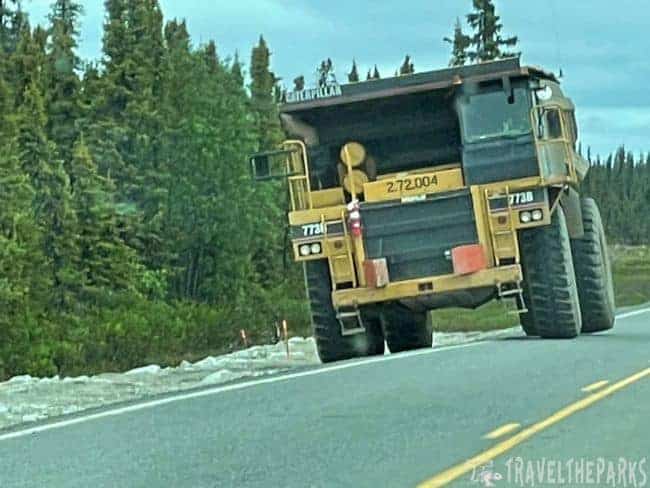
At the Gulkana River Salmon Spawning viewpoint (MM190), we took a snack break. The paved parking lot has informational signs, restrooms, and a viewing platform over the river. Magnificent views of the distant Wrangell mountains and summit lake area. On the opposite side of the highway, the Trans-Alaska Pipeline corridor parallels the road. Ground squirrels were everywhere, chasing each other in the alders.
We drive around the edge of Summit lake. It is the location of the annual Arctic Man competition. They hold it every April. The competition draws hundreds of Alaskan snowmobilers who want to challenge the mountain course. Adrenaline junkies live for the competition.
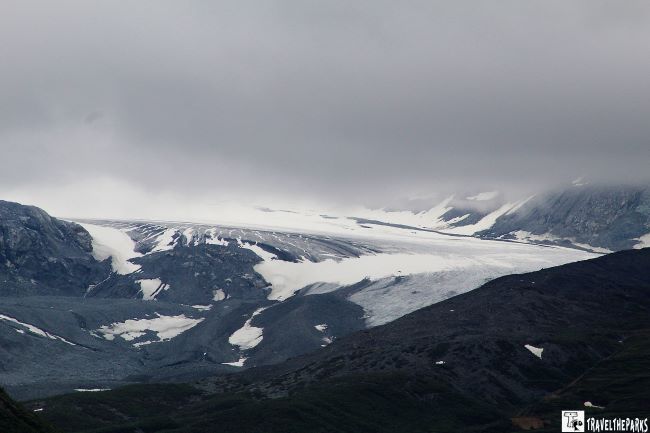
The Richardson Monument (MM 227) – A Historic Landmark Along the Richardson Highway
Rising to Isabel pass elevation 3280 feet, we stopped at the Richardson monument. The monument here honors former Alaska road commission director, Captain Wilds P. Richardson. Outstanding views of the Gulkana Glacier in the Alaska range. Interesting reading on the gold rush women. Specifically Isabelle Bernette, who crossed the pass in 1902 on her way to Fairbanks. She and her husband were the founders of Fairbanks.
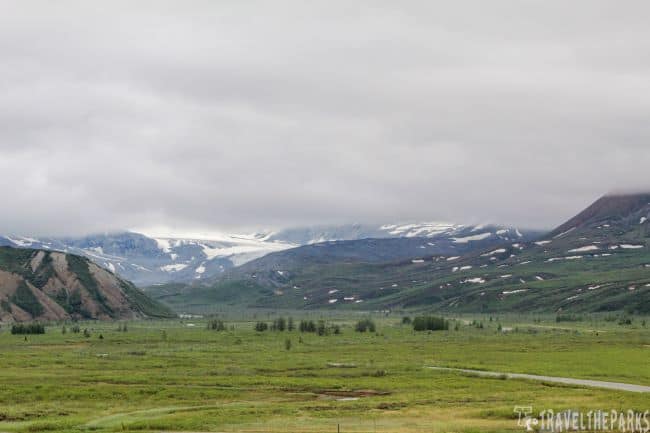
Hike Gulkana Glacier – An Unforgettable Outdoor Adventure Along the Richardson Highway
The trailhead to the glacier is a short 4-mile drive on a gravel road. At the end are a few campsites. Before hiking pack along snacks and bring a refillable water bottle. Navigate over the suspension bridge over Phelan Creek to start the trail. The bridge is wobbly, so I suggest one at a time crossing. It is not the most stable. We only did 1.5-miles before turning around. The trail was very muddy with lots of loose scree rock. I would suggest having waterproof hiking boots or bring an extra pair of shoes. Trekking poles are extremely beneficial.
If you want to get a closer view of the glacier you will have fjord Phelan creek. This was not what we were willing to endure today. The idea of stepping into the chilly waters without a change of clothes was not appealing. However, the views of the toe of the glacier are beautiful even with the overcast skies we have today.
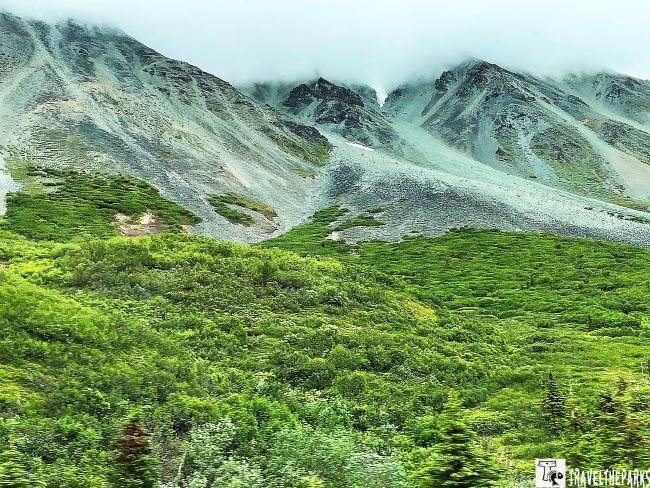
Rainbow Ridge
We saw some of the most stunning scenery on this stretch of the highway. Make sure you have a camera! Just north of Isabel Pass, the highlight was Rainbow Ridge. The ridge rises 6,000 foot beside the road. It was named because of the vibrant washes of geologic colors that are showcased on its steep slopes. The vivid reds and greens are apparently volcanic rock, while the yellows and pastels are primarily composed of siltstone and sandstone.
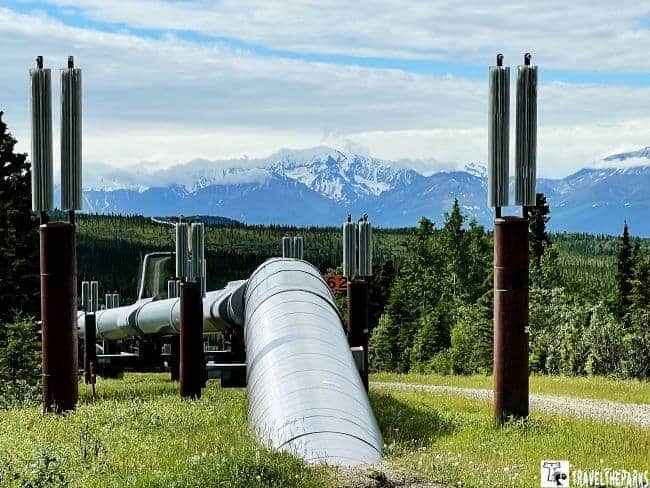
Denali Fault/Pipeline Viewpoint (MM243)
They built the pipeline between 1973 and 1971. covering 800-miles this feat of engineering, transporting oil from Prudhoe Bay across Alaska to Valdez. The viewpoint has spectacular views of the Alaska Range. The informational kiosk has an in-depth overview of the pipeline, including the construction, built-in earthquake detection system and diagrams of the pipe itself. It is truly a remarkable feat of engineering.
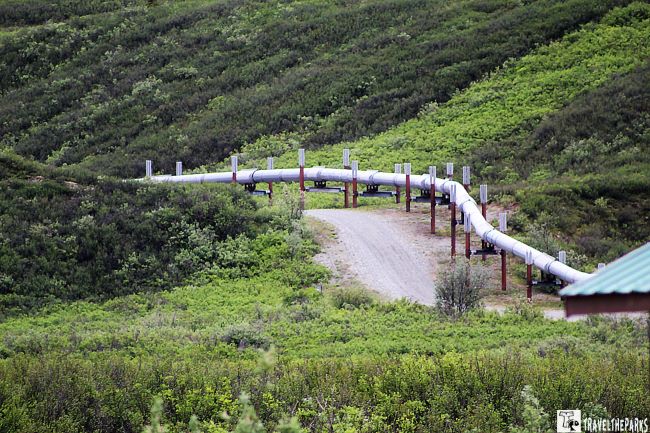
The highway slowly descends towards the Delta River, an 80 mile tributary of the Tanana River. The mountains of the Alaska Range get more dramatic as we approached Delta Junction.
We pass Fort Greely (MM261), a strategic airfield during World War II and used as one of the US Army’s cold-weather training and testing. Established in 1942, it was named in honor of Major General Adolphus Greely. It is said to be the coldest place in Alaska-home of the Cold Regions Test Center (CRTC).
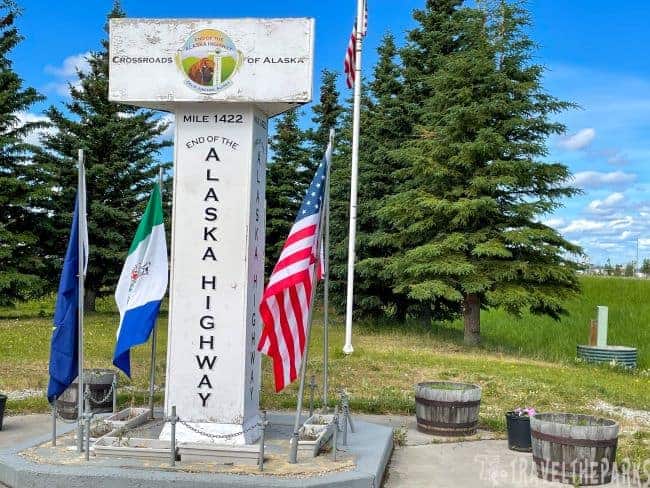
Explore Delta Junction – Your Ultimate Guide to Things to Do in Town
It was time for a comfort break, and Delta Junction was the perfect stopover. There are lots of things to do in this small town at the intersection of the Richardson and Alaska highways.
Delta Junction Visitor Center/Chamber of Commerce (MM266)
Our first stop was the visitor’s center. They have informational signs just outside the pavilion that highlight the agricultural aspect of this floodplain valley. The Delta river has created a fertile floodplain. If you walk the outside area, there are sculptures of giant mosquitoes and a cutout of the Alaska pipeline. The inside building has a small gift store and has knowledgeable staff members and informational brochures of the area.
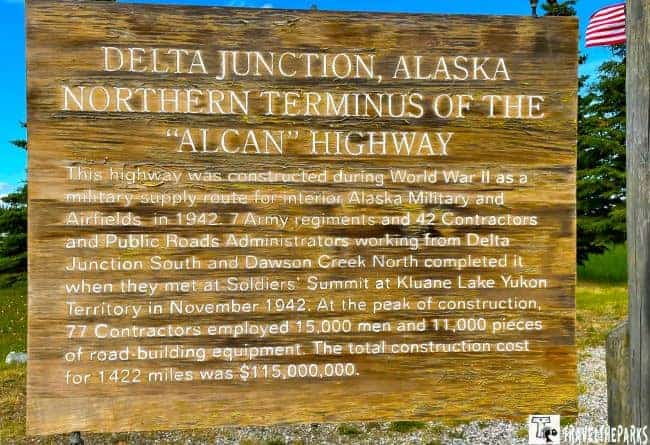
Intersection on the Alaska Highway (MM266)
The US Army built the highway in 1942 during World War II as a supply route between the contiguous US states and Alaska. Delta Junction is the end of the historic 1,422-mile Alaska Highway (Alcan) and Dawson Creek is MM 0. From this terminus, either travelers headed north to Fairbanks, or south to Valdez on the Richardson highway. The monument marks the official end of the Alaska Highway. You can even get a certificate that will endorse that you completed the drive from Dawson to Delta Junction.

Sullivan Roadhouse Historical Museum (MM266)
Explore the oldest original roadhouse in interior Alaska. The Sullivan Roadhouse Historical Museum is the first stop if you are interested in Alaska’s history. Added to the National Register of Historic Places in 1979, it is at the junction of the Alaska (Alcan) and Richardson Highway. John and Florence Sullivan built the cabin in 1905 along the banks of Delta Creek during the Klondike gold rush days. It was situated directly along Valdez-Fairbanks Trail or the Donnelly-Washburn Cut-Off. Stagecoaches were used to complete 380-mile 2-week trip. Roadhouses were vital, providing meals, lodging and camaraderie.
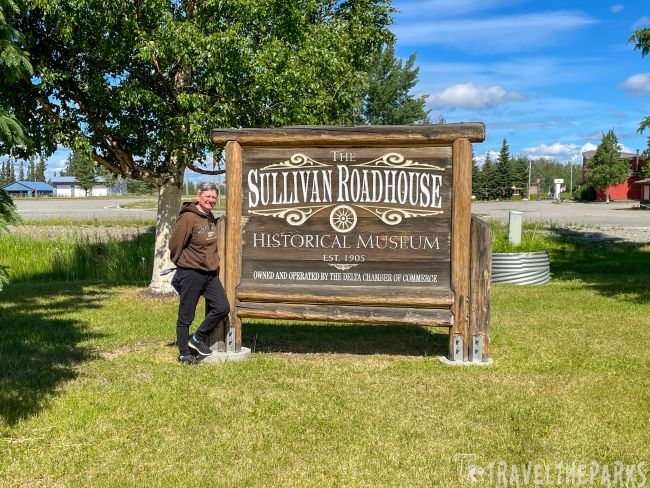
The trail direction changed in 1906, but the Sullivans persevered. They moved the roadhouse re-assembled in its entirety to a new location 4.5-miles due east. However, in 1921, with the advent of the automobile and railroad, the Alaska Road Commission stopped maintaining the trail. The Sullivan moved to Fairbanks, and the roadhouse fell into disrepair with many of the outbuildings-blacksmith shop, barn and stable all succumbed to elements. In 1942, it became part of the Fort Greely bordering the Oklahoma Bombing Range. Used as a military shelter, they saved many of the original furnishings and in In 1996, the U.S. Army Legacy Fund moved it to its current location..
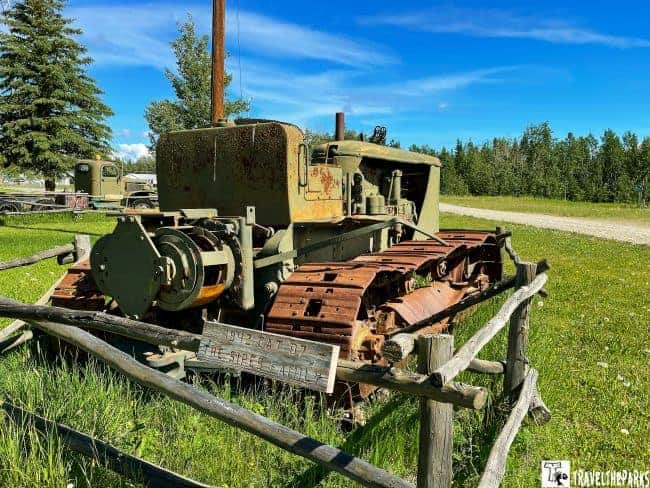
Today, the restored log structure showcases authentic artifacts, documents and displays, providing great insight into the lifestyle of the early 1900s. We felt the personal letters really brought home to us the life of the pioneers in Alaska. The docent was wonderful recommending other places to see while on our trip.The roadhouse has overcome great odds of being a museum and is worth taking the time to see if you are in Delta Junction. Best of all, it is free!
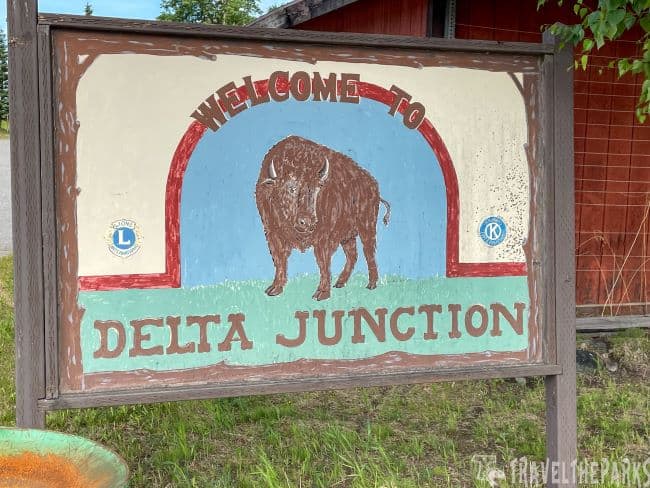
Eat at the Buffalo Center Drive-In (MM265)
This was such a significant find beside the Sullivan Roadhouse Museum. The best place to eat lunch in Delta Junction in the summer! You place your order at the window and they deliver it to your table or your car. Same as in the classic 1950s. There speciality is burgers, sandwiches and ice cream. We chose the Alaska Halibut fish and chips. The food at the Buffalo Center drive-in was delicious and the service couldn’t have been great. We ate at the outside tables and they brought the food to us and they only take cash.
Big Delta State Historical Park – Rika’s Roadhouse (MM 275)
It is about 8 miles north of Delta Junction at Mile 275 on the banks of the Tanana River. This historical treasure lies along the Valdez-to-Fairbanks trail (Richardson Highway). Big Delta State Historical Park is a remarkable glimpse into the past and the isolation of the Alaska frontier. Many travellers, traders, and prospectors venturing to the interior gold fields of Fairbanks overcame incredible odds on this epic journey.

The 10-acre park houses many well-maintained historical buildings, an array of rustic buildings, a campground (23 RV camping sites), hiking trails and a picnic area. There is NO admission fee. However, there is a $5 parking fee that helps to preserve the park. There is a brochure available at the entrance that explains what each building’s history. We took an hour to do the self-guided walk tour of the historical landmark buildings. Telegraph Building built in 1907 was fascinating. Part of the Washington DC to Alaska Military Cable and Telegraph System (WAMCATS) it was a brief trip back in time! The large barn contained old blacksmith tools, horse tack, dog harnesses, and sleds.

Step Back in Time at Rika’s Roadhouse – A Historic Landmark Along the Richardson Highway
The Richardson Highway has many historical roadhouses along its route. Rika’s Roadhouse was just one of many that lined the trail. The inspiration of Ben Bennett, he built the roadhouse-trading post in 1904. Later in 1909, Yugoslavia, John HajdukovishIt bought the trading post and constructed a new roadhouse in 1913. During this timeframe, he created a ferry service to help travellers cross the river. He hired Rika Wallen, a Swedish immigrant in 1917, as the first manager. In 1923 she purchased and named the roadhouse-Rika’s. It functioned till 1940. They restored the building in 1971 and keeps much of its original charm. There is also a gift shop and restaurant in the roadhouse.
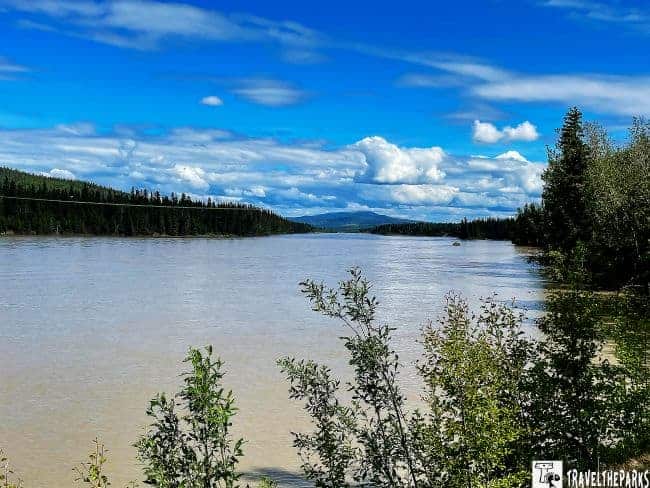
Leaving the historic park, we cross the Big Delta Bridge and Trans-Alaska Pipeline Bridge. The pipeline crosses over the river, having its own dedicated bridge.
The highway continues past Quartz Lake State Recreation Area (MM 277), Birch Lake State Recreation Site (MM305) and Salcha River State Recreation Site (MM 323) are ideal locations for camping and fishing.
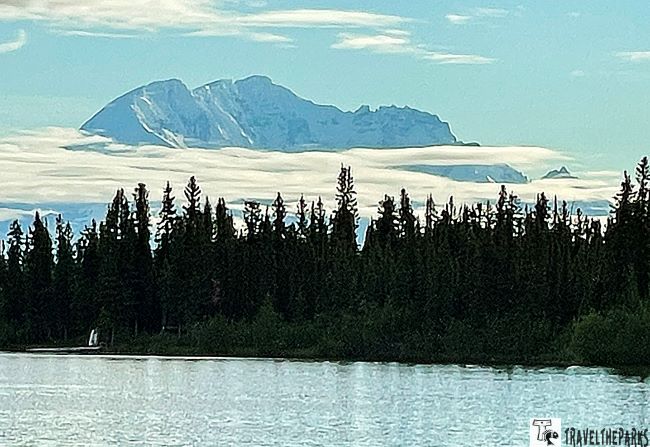
Eielson Airforce Base to Fairbanks
Approximately 26-miles south of Fairbanks at MM 341, you pass Eielson AFB. Established in 1943 during WW II and used during the Cold War as a base for the aircraft that refueled the B-52’s while in the air. The base operated as a training field for the Air Force, providing close air support and offensive operations. It was said you could judge the seriousness of the world news by how few refuelers were on the ground. Today, the base is used for cold weather exercises and home to the 354th Fighter Wing group.
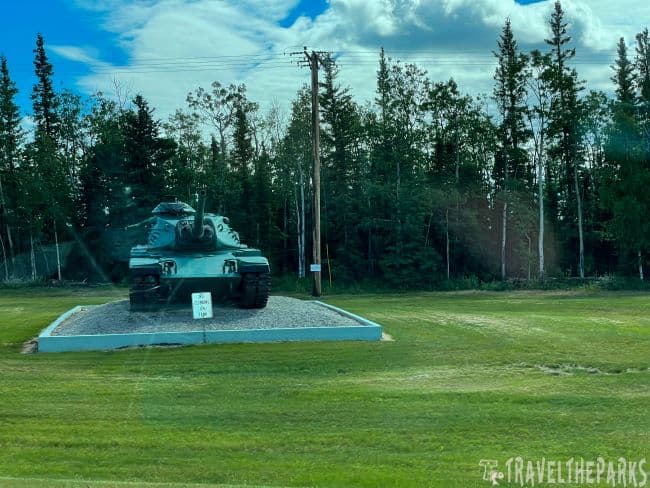
Chena Lakes Recreation Area (MM 347) is home to the Chena Hot Springs. Locals use the trails for winter/summer recreation. The park has 397 square miles of forests, rivers, and alpine tundra. The park is popular, and we loved our guided fishing on the Chena river fishing for grayling. You can also visit the Aurora Ice Museum and take a dip in the outdoor volcanic/thermal hot spring. Hopefully, someday we will get an opportunity to view the aurora borealis.

Fairbanks is the end of the Richardson highway (MM368). From Fairbanks, most visitors head south towards Denali National Park & Preserve. Those seeking solace head for the Dalton Highway, looking for the solitude that the tundra provides. We are spending the next three days here at the Riverbend Cabins. An excellent location just outside the small town of North Pole.

Final Thoughts on Epic Stops Along the Way Gakona to Delta Junction on the Richardson Highway
The Richardson highway has amazing scenery. The construction set us back a few hours, however; we made the most of the stops we made along the way. The fishing and hiking were spectacular, and the mosquitoes were not too bad. The next trip, we hope to get to Valdez to see the southern portion of the highway. We hope to take the ferry from the Seward Highway side to get the most spectacular views.
The drive from Gakona to Delta Junction, although isolated, has beautiful landscapes of interior Alaska. I look forward to seeing it again on our return trip.
Have you traveled the Richardson Highway from Gakona to Delta Junction? What trails did you hike? Did you find the serenity of the wilderness?? Share your thoughts in the comments below.




